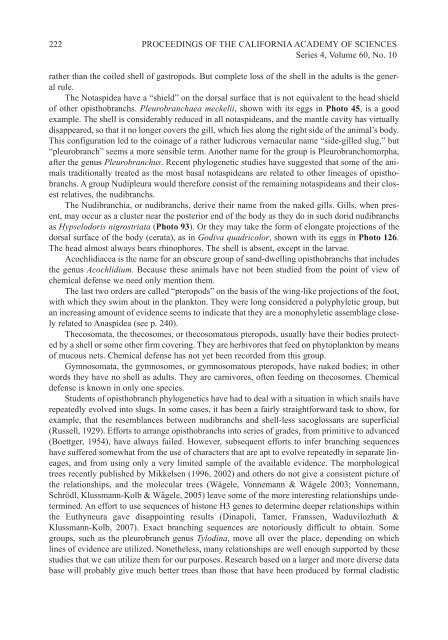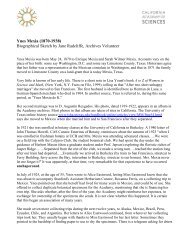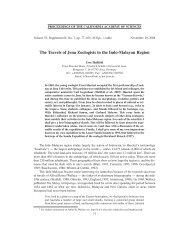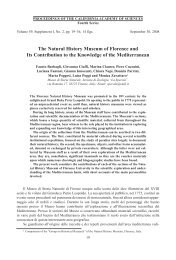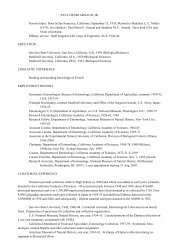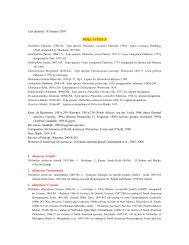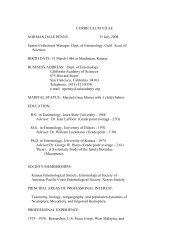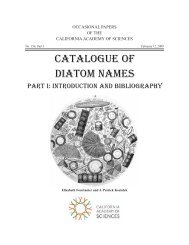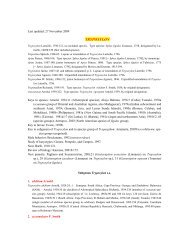Cimino&Ghiselin-tmpZXYZ:Template Proceedings_1.qxd.qxd
Cimino&Ghiselin-tmpZXYZ:Template Proceedings_1.qxd.qxd
Cimino&Ghiselin-tmpZXYZ:Template Proceedings_1.qxd.qxd
You also want an ePaper? Increase the reach of your titles
YUMPU automatically turns print PDFs into web optimized ePapers that Google loves.
222 PROCEEDINGS OF THE CALIFORNIA ACADEMY OF SCIENCES<br />
Series 4, Volume 60, No. 10<br />
rather than the coiled shell of gastropods. But complete loss of the shell in the adults is the general<br />
rule.<br />
The Notaspidea have a “shield” on the dorsal surface that is not equivalent to the head shield<br />
of other opisthobranchs. Pleurobranchaea meckelii, shown with its eggs in Photo 45, is a good<br />
example. The shell is considerably reduced in all notaspideans, and the mantle cavity has virtually<br />
disappeared, so that it no longer covers the gill, which lies along the right side of the animal’s body.<br />
This configuration led to the coinage of a rather ludicrous vernacular name “side-gilled slug,” but<br />
“pleurobranch” seems a more sensible term. Another name for the group is Pleurobranchomorpha,<br />
after the genus Pleurobranchus. Recent phylogenetic studies have suggested that some of the animals<br />
traditionally treated as the most basal notaspideans are related to other lineages of opisthobranchs.<br />
A group Nudipleura would therefore consist of the remaining notaspideans and their closest<br />
relatives, the nudibranchs.<br />
The Nudibranchia, or nudibranchs, derive their name from the naked gills. Gills, when present,<br />
may occur as a cluster near the posterior end of the body as they do in such dorid nudibranchs<br />
as Hypselodoris nigrostriata (Photo 93). Or they may take the form of elongate projections of the<br />
dorsal surface of the body (cerata), as in Godiva quadricolor, shown with its eggs in Photo 126.<br />
The head almost always bears rhinophores. The shell is absent, except in the larvae.<br />
Acochlidiacea is the name for an obscure group of sand-dwelling opisthobranchs that includes<br />
the genus Acochlidium. Because these animals have not been studied from the point of view of<br />
chemical defense we need only mention them.<br />
The last two orders are called “pteropods” on the basis of the wing-like projections of the foot,<br />
with which they swim about in the plankton. They were long considered a polyphyletic group, but<br />
an increasing amount of evidence seems to indicate that they are a monophyletic assemblage closely<br />
related to Anaspidea (see p. 240).<br />
Thecosomata, the thecosomes, or thecosomatous pteropods, usually have their bodies protected<br />
by a shell or some other firm covering. They are herbivores that feed on phytoplankton by means<br />
of mucous nets. Chemical defense has not yet been recorded from this group.<br />
Gymnosomata, the gymnosomes, or gymnosomatous pteropods, have naked bodies; in other<br />
words they have no shell as adults. They are carnivores, often feeding on thecosomes. Chemical<br />
defense is known in only one species.<br />
Students of opisthobranch phylogenetics have had to deal with a situation in which snails have<br />
repeatedly evolved into slugs. In some cases, it has been a fairly straightforward task to show, for<br />
example, that the resemblances between nudibranchs and shell-less sacoglossans are superficial<br />
(Russell, 1929). Efforts to arrange opisthobranchs into series of grades, from primitive to advanced<br />
(Boettger, 1954), have always failed. However, subsequent efforts to infer branching sequences<br />
have suffered somewhat from the use of characters that are apt to evolve repeatedly in separate lineages,<br />
and from using only a very limited sample of the available evidence. The morphological<br />
trees recently published by Mikkelsen (1996, 2002) and others do not give a consistent picture of<br />
the relationships, and the molecular trees (Wägele, Vonnemann & Wägele 2003; Vonnemann,<br />
Schrödl, Klussmann-Kolb & Wägele, 2005) leave some of the more interesting relationships undetermined.<br />
An effort to use sequences of histone H3 genes to determine deeper relationships within<br />
the Euthyneura gave disappointing results (Dinapoli, Tamer, Franssen, Waduvilozhath &<br />
Klussmann-Kolb, 2007). Exact branching sequences are notoriously difficult to obtain. Some<br />
groups, such as the pleurobranch genus Tylodina, move all over the place, depending on which<br />
lines of evidence are utilized. Nonetheless, many relationships are well enough supported by these<br />
studies that we can utilize them for our purposes. Research based on a larger and more diverse data<br />
base will probably give much better trees than those that have been produced by formal cladistic


